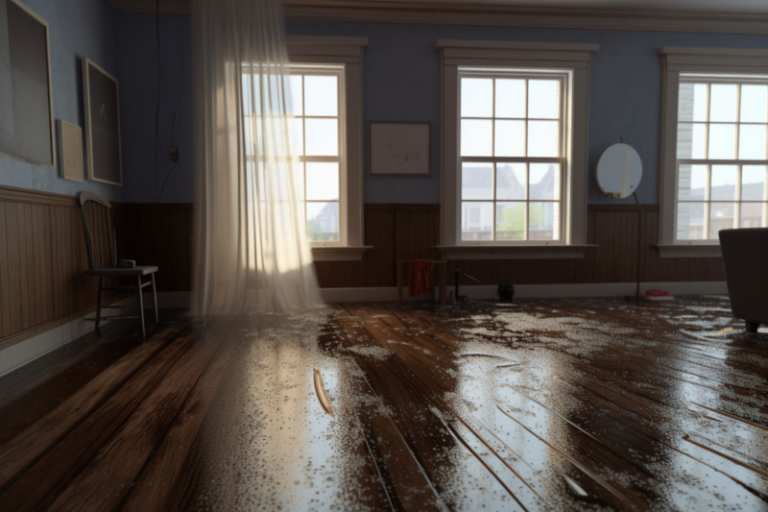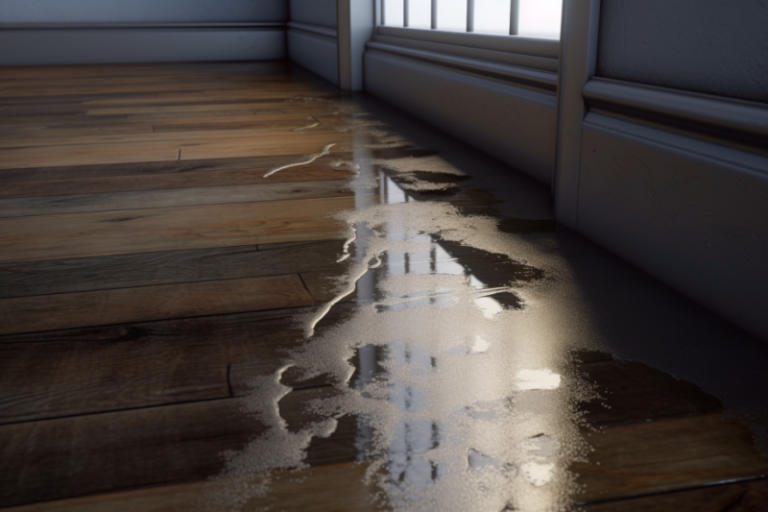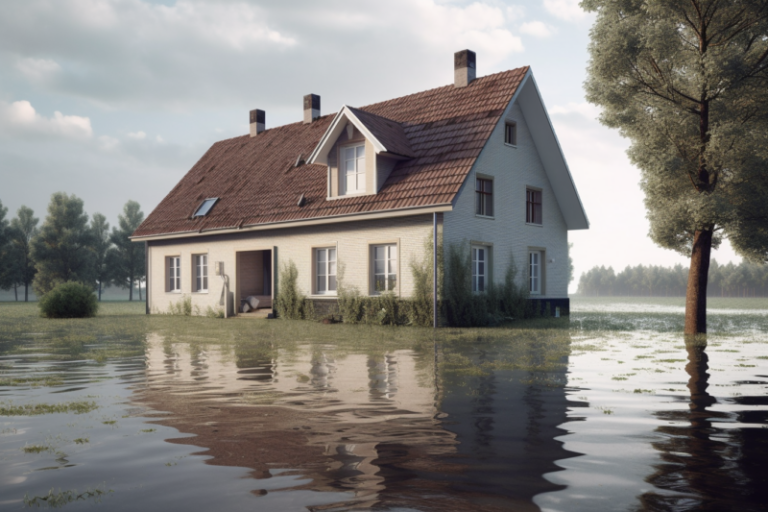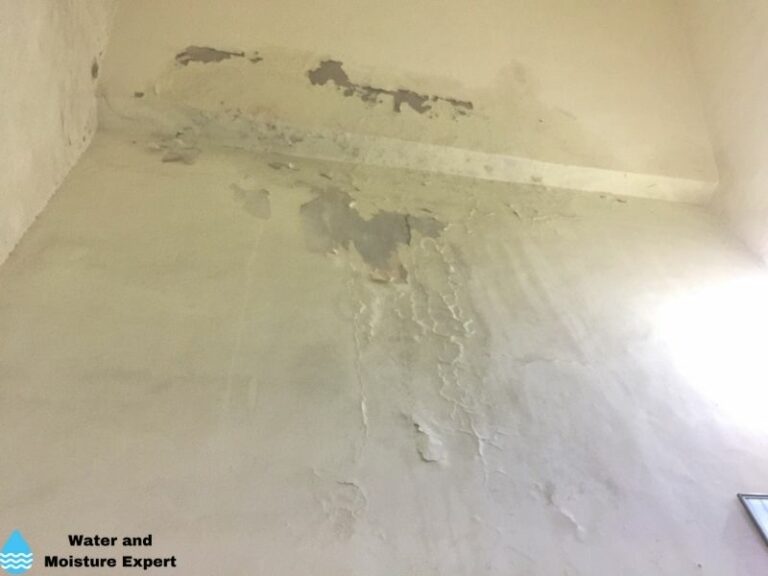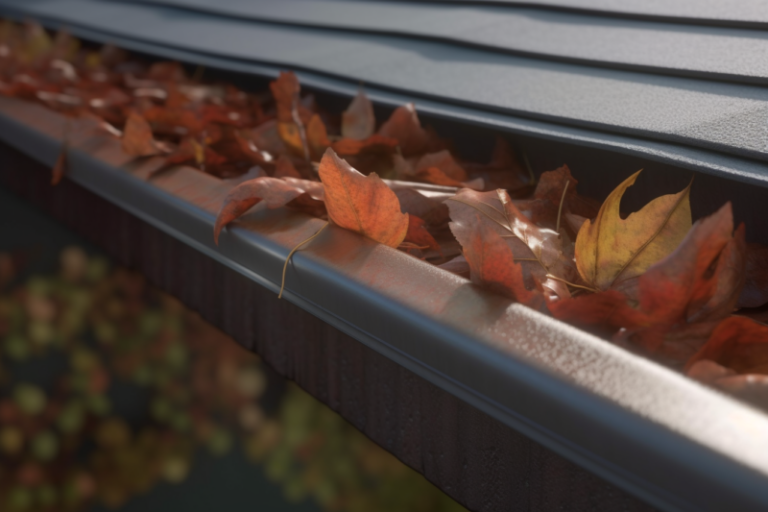Expert Guide to Managing Water Damage on 2nd Floor
If you’re concerned about water damage on your 2nd floor, we have the expertise to help. Let’s discuss what actions you can take to prevent and repair any damage that may have been done.
Water damage 2nd floor:
Various reasons can cause water damage on the second floor of a home and can lead to extensive and costly repairs. There are three main types of water damage: clean water damage, grey water damage, and black water damage. To prevent further damage, it’s essential to turn off the water supply, call a professional, and begin the drying process. Regular maintenance of appliances, gutters, and downspouts can help prevent water damage. Sealing windows and doors can also prevent water from seeping in during heavy rain.
Learn about the common causes of water damage on the second floor of homes and apartments, along with expert tips on preventing and fixing such issues.
Find out how to deal with the aftermath of a water damage incident and minimize the associated costs. Keep reading to know more.
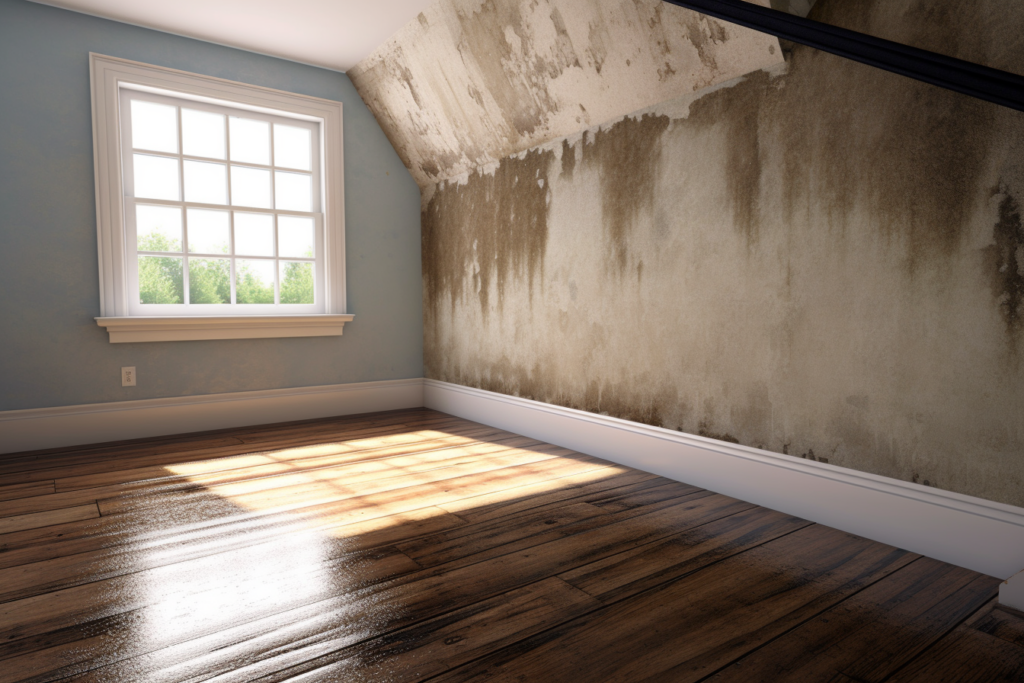
Contents
- 1 Secondary Floor Water Damage: A Professional Assessment
- 2 Locate the source of the leak
- 3 What is the Required Duration of Water Exposure on Flooring to Cause Damage?
- 4 What Happens if Water Gets Under Your Floor?
- 5 How long does it take for a floor to dry out after a leak?
Secondary Floor Water Damage: A Professional Assessment
Water damage on the second floor of your home can happen for many reasons. Some potential culprits are leaking pipes, burst water heaters, and poorly sealed windows.
However, regardless of the cause, the damage can be extensive and costly. In this article, we’ll explore the different types of water damage that can happen to the second floor of your home, the steps you need to take when your home is affected, and finally, some helpful tips to prevent future damage.
• Types of Water Damage
Water damage can be put into three main types: clean water damage, grey water damage, and black water damage. Understanding these types can help you identify the severity of the situation.
- Clean Water Damage – This type of damage is caused by clean, fresh water from a burst pipe, appliance or sink overflow, or rainwater. Without any contaminants present, clean water damage is considered the least severe of the three types. However, acting quickly before the water becomes contaminated is still important, as it can lead to other issues like mold growth.
- Grey Water Damage – Grey water damage is caused by water that contains contaminants but not sewage. Examples of grey water are washing machine or dishwasher overflows, or water from bathroom sinks and showers. Grey water damage is more serious than clean water damage as it can cause illness if ingested or handled without gloves.
- Black Water Damage – This is the most severe type of water damage as it involves water that contains harmful and possibly lethal contaminants such as human waste or chemicals. Examples include sewage backups or flooding from rivers and lakes. Blackwater damage requires immediate attention from professionals who are certified in dealing with hazardous materials.
• What to Do When Water Damage Occurs
You should take immediate action if you notice any signs of water damage on your second floor, such as water spots on the ceiling or walls, warped flooring, or peeling paint.
Here are some steps you can take to minimize the damage:
- Turn off the Water Supply – The first step to stopping the damage is to stop the water source. Turn off the main water supply or shut off the valve that leads to the affected area.
- Assess the Damage – Take a moment to assess the damage and document everything with photos or videos. This documentation can be useful when you’re filing an insurance claim.
- Call a Professional – Contact a professional water damage restoration company as soon as possible to prevent further damage. These experts are equipped to deal with all types of water damage and have the latest equipment to dry out and sanitize the affected area.
- Remove the Water – If the water level is low, try using a wet/dry vacuum to suck up the water. However, if the water level is high, you should not attempt to remove it yourself because of the possibility of electrocution due to standing water.
- Begin the Drying Process – Once the water is removed, the drying process begins. The professionals will use fans, dehumidifiers, and other specialized equipment to dry out the affected area as quickly as possible.
- Restoration – After the drying process is complete, the professionals will begin the restoration process. This includes things like replacing drywall, flooring, and other affected materials. They can also test for mold and other harmful substances that can grow in damp areas.
• Preventing Water Damage
The best way to avoid water damage is to take preventative measures. Some of the ways you can prevent water damage include:
- Regular Maintenance – Regular maintenance of appliances, pipes, and gutters can help prevent water damage from occurring.
- Sealing Windows and Doors – Proper sealing of windows and doors can prevent water from seeping in during heavy rain.
- Cleaning Gutters and Downspouts – Regular cleaning of gutters and downspouts can prevent water from backing up and causing damage to the roof and foundation of your home.
If you live in a two-story home, one of the worst things that could happen is a water leak on the second floor. It can damage your flooring, walls, and even your ceiling, not to mention the potential for creating mold and other health problems.
This is a situation that requires immediate attention to prevent further damage. In this article, we will discuss what to do if water leaks to the second floor and how to prevent it from happening in the future.
Locate the source of the leak
If you notice water leaks on the second floor, the first step is to determine the source of the leak. It could be a plumbing problem, a problem with the roof, or a leaking appliance.
Turn off the water supply to prevent further water damage, and try to pinpoint where the water is coming from.
If you cannot locate the source of the leak, call a professional plumber or roofer.
• Call a professional
Water leaks can be a serious problem, and it’s important to take quick action to prevent further damage to your home.
Call a professional plumber or roofer to assess the situation and provide expert recommendations on addressing the issue.
The sooner you can get a professional on the scene, the better your chance of preventing further damage.
• Remove any standing water
If standing water is on the floor or furniture, remove as much water as possible. Use a wet/dry vacuum, mop, or towels to soak up the water. The longer the water sits, the more damage it can cause.
• Dry out the area
After removing the standing water, it’s important to dry out the area as quickly as possible. Use fans or a dehumidifier to circulate air and prevent mold growth.
You may also want to open windows and doors to increase airflow. If you have access to a wet/dry vac, use it to extract any remaining moisture from the affected area.
• Contact your insurance company
If you have homeowners insurance, you should contact your insurance company as soon as possible to report the water damage.
They will send out an adjuster to assess the damage and determine if it is covered under your policy. If it is covered, they will work with you to complete the necessary repairs.
• Prevent future water damage
Water leaks on the second floor can be a frustrating and expensive problem. However, you can take steps to prevent it from happening in the future. Here are a few suggestions:
- Regularly inspect your roof for any signs of damage or wear and tear. Replace missing shingles or tiles and repair any leaks as soon as you notice them.
- Install a sump pump in your basement to prevent water from accumulating and causing damage.
- Inspect your plumbing regularly and fix any leaks as soon as you notice them.
- Install a water leak detection system in your home that will alert you if there is a leak.
- Keep your gutters clean and clear of debris to ensure proper drainage away from your home.
- Always turn off your water supply before leaving your home for an extended period.
| What to do if water leaks to the second floor? |
|---|
| 1. Turn off the water supply at the main valve. |
| 2. Locate the source of the leak and try to contain it with a bucket, towels or other materials. |
| 3. Call a professional plumber to fix the leak if you cannot fix it yourself. |
| 4. Check for any ceiling, wall, or floor damage and make necessary repairs. |
| 5. If the leak has caused extensive damage or poses a risk to your safety, contact your insurance company. |
What is the Required Duration of Water Exposure on Flooring to Cause Damage?
Water damage can occur in different forms and from different sources.
It can be caused by natural disasters such as floods, heavy rains, hurricanes, or human activities such as leaking pipes, overflowing toilets or sinks, or burst water heaters.
• Types of Water Damage
Water damage can be categorized into three types, each with varying degrees of severity:
– Category 1: Clean Water
This category refers to safe water for human consumption and does not pose an immediate threat.
Examples of clean water sources include broken water supply lines, tub or sink overflows with no contaminants, and appliance malfunctions involving water supply lines.
– Category 2: Grey Water
Greywater is water that contains some level of contamination or pollutants but is not considered hazardous or toxic. Examples include water from washing machines, dishwashers, or aquariums.
– Category 3: Black Water
Blackwater is highly contaminated and poses a significant risk to human health. This type of water contains bacteria, viruses, or other harmful microorganisms.
Examples include sewage backup, floodwater, or water from a toilet overflow containing fecal matter.
• How Long Does It Take for Water on the Floor to Cause Damage?
The time it takes for water on the floor to cause damage depends on several factors, such as the type of water, the surface it is on, and the duration of exposure before it is removed.
Generally, the longer water remains on a surface, the greater the chances of damage occurring.
– Hardwood Floors
Hardwood floors are susceptible to water damage since they absorb moisture. When exposed to water, the wood will swell and warp, causing unsightly buckling and cupping.
Hardwood floors should generally dry within 24-48 hours to avoid permanent water damage.
– Carpeted Floors
Carpeted floors can hold a significant amount of water and are a breeding ground for mold and fungi. The longer the carpet remains wet, the less likely it is to be salvaged.
Generally, a wet carpet should be removed and replaced if it has been exposed to water for more than 48 hours.
– Concrete Floors
Concrete floors are relatively impervious to water damage. However, water can seep into cracks and cause the concrete to deteriorate over time.
In general, concrete should dry within 48 hours to avoid permanent damage.
• How to Prevent Water Damage
Preventing water damage is essential to ensure the safety of your home and its occupants. Here are some tips on how to prevent water damage:
– Regular Maintenance
Regular maintenance of plumbing fixtures, water heaters, and appliances can prevent leaks and water damage.
– Inspect Pipes
Check pipes regularly for signs of corrosion, cracks, or leaks. It is also essential to check plumbing joints for signs of leaks and replace old or damaged fittings.
– Clean Gutters and Downspouts
Clear out gutters and downspouts regularly to ensure water flows away from your home and does not accumulate near the foundation.
– Install Water Alarms
Install water alarms near appliances, sump pumps, and other potential sources of water damage. These alarms can help detect water leaks early and mitigate damage.
What Happens if Water Gets Under Your Floor?
Water is a great necessity for life, but at the same time, it can be a disaster if it seeps under your floorboards.
Water damage is one of the most significant problems that homeowners face, and if not addressed immediately, it can severely compromise the integrity of your house.
Water left to accumulate under your floor can rot wood, corrode metal, and encourage mold growth, leading to an unhealthy living environment.
• Indicators of Water Seepage Under Your Floor
The hallmark sign of water seepage under your floor is warped, bowed, or sagging floorboards. It is important to check for water leaks, especially after a heavy storm or water disaster, because tiny amounts of seepage can accumulate over time.
Before you know it, the damage is catastrophic. Other signs of water damage include:
- Dampness or discolored patches on the floor or walls
- Soft spots on the floors
- A musty, damp smell
- An increase in the humidity level of your house
• Risks of Water Damage Under Your Floor
Water damage under your floor can lead to some of the most severe risks to your home’s structural integrity.
The extent of the damage depends on the length of time the water was left to seep under the flooring. The following are some of the risks associated with water damage:
– Weakening of the Floor Structure
Water can erode wood, corrode metal fasteners, and weaken the foundation of your house. Over time, your floor structure may sag or buckle, leading to structural failure.
– Mold Growth
Mold spores thrive in damp environments, and a moisture build-up under your flooring can provide the perfect environment for mold growth.
The growth of mold can lead to adverse health problems, particularly for those with respiratory issues.
– Health Problems
Health issues may arise when mold or mildew growth occurs. These contaminants can cause respiratory illnesses such as asthma and, in rare cases, even death.
– Pest Infestations
Pests thrive in damp environments, particularly termites, that can cause extensive damage to wood-based floors.
• Find and Tackle the Root Cause
The first step to addressing water damage under your floor is identifying the root cause. This could be anything from a burst pipe, a leaky roof, or rising dampness.
Once you find the issue, you should tackle it immediately to prevent further water damage. If you can’t find the root cause of the water damage, you should consider consulting a professional plumber to inspect your property.
• Drying Out the Water
After identifying the cause of the water damage, you should take steps to dry out the moisture under the floor.
The best way to do this is to remove the damaged flooring to allow proper air circulation to dry out the area.
This will also help you to find the extent of the damage and assess the repairs you need to undertake. If possible, use a dehumidifier to help remove excess moisture in the air.
• Assess the Damage
Assessing the water damage is critical to determining the repairs that you need to make. Depending on the level of water damage, you may need to replace some or all of the flooring.
If the structural integrity of the flooring is compromised, you may have to hire a professional contractor to handle the repair.
• Preventative Measures
Preventing water damage under your floor is much easier and cheaper than addressing the problem after it has occurred. Some preventative measures include:
– Routine Maintenance
Regular inspections of your plumbing and roofing systems can help detect potential problems before they become catastrophic.
– Install a Sump Pump
A sump pump is an effective way of preventing unwanted water under your floor. The pump can quickly remove water from your basement or crawl space to prevent water accumulation.
– Proper Ventilation
Adequate ventilation in your house can prevent humid air from accumulating, making it difficult for mold or mildew to grow.
Effects | Possible causes | Solution |
|---|---|---|
Warped or buckled floorboards | Water seepage from pipes, floods | Clean and dry the area thoroughly, use mold inhibitors, or hire a professional mold remediation service. |
Mold and mildew growth | Poor ventilation, humidity, water infiltration | Clean and dry the area thoroughly, use mold inhibitors, or hire a professional mold remediation service. |
Rotting or decay of subfloor | Long-standing water infiltration, poor subfloor ventilation or insulation | Replace affected area or subflooring, improve ventilation or insulation, address underlying problem (leaky pipes, poor drainage) |
How long does it take for a floor to dry out after a leak?
As a professional in the water damage restoration industry, I have seen many cases where homeowners underestimate the amount of time it takes for a floor to dry out after a leak.
Ignoring a wet floor can lead to further damage, such as mold growth, and create an unhealthy environment for you and your family.
• Understanding the extent of the water damage
The first step in knowing how long it will take for your floor to dry out is to understand the extent of the water damage.
Factors that influence the drying time of a floor include the type of flooring, the severity of the leak, and the humidity and temperature of the room. For example, a tile or concrete floor will dry out faster than a hardwood floor because they are less porous.
Additionally, a small leak caught early on will dry out faster than a major water intrusion affecting multiple rooms.
If you are uncertain about the extent of the water damage, it is essential to call in a professional to assess the situation.
They can give you an accurate estimate of how long it will take for your floor to dry out and prevent further damage.
• Drying out the floor
Once you have assessed the extent of the water damage, it is time to dry out the floor. The first step is to remove any standing water and extract excess water from the flooring.
This can be done with a shop vac or a water extraction machine, which involves sucking water out of the affected area.
After removing the standing water, it is time to begin the drying process. The most effective way to dry out a floor is to use high-powered dehumidifiers, fans, and air movers.
These machines will remove excess moisture from the room and circulate air to speed up drying time. It’s best to start the drying process as soon as possible after the leak, as this will help prevent mold growth.
• How long does it take for a floor to dry out?
The drying time for a floor depends on the extent of the water damage and the type of flooring. On average, it takes 2-3 days for a tile or concrete floor to dry out, while a hardwood floor can take anywhere from 4-7 days.
However, these are just estimates, and the drying time can vary depending on the humidity and temperature of the room.
To ensure your floor dries out as quickly as possible, it is essential to keep the room warm and dry. You can do this by turning up the heat in the room and using fans and air movers to circulate air.
It’s also important to open windows and doors to allow fresh air to circulate.
• What to do after the floor has dried out?
Once the floor has dried out, inspecting the area for any signs of mold growth or other damage is essential.
If you notice any mold growth, it’s best to call in a professional to assess the situation and take care of the mold remediation process.
It’s also important to clean and disinfect the affected area thoroughly. Use a mixture of bleach and water to clean the surface thoroughly, and dry the area completely before replacing any flooring or furniture.
• Conclusion
In conclusion, the time it takes to dry out a floor after a leak depends on several factors, including the type of flooring, the severity of the leak, and the humidity and temperature of the room.
On average, it takes 2-3 days for a tile or concrete floor to dry out, while a hardwood floor can take anywhere from 4-7 days.
If you experience a leak, it’s essential to call in a professional to assess the extent of the damage and help you dry out the floor as quickly as possible.
Remember to keep the room warm and dry, use fans and air movers to circulate air, and inspect the area for any signs of mold growth once the floor has dried out.
Types of Flooring | Time to Dry Out after a Leak |
|---|---|
Concrete | 24-72 hours |
Tile | 24-72 hours |
Hardwood | 3-5 days |
Laminate | 2-4 days |
Carpet | 2-7 days |

